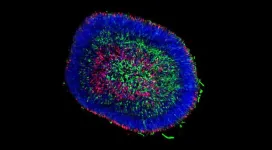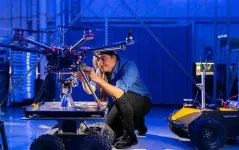(Press-News.org) More than 3 billion years ago, Mars intermittently had liquid water on its surface. After the planet lost much of its atmosphere, however, surface water could no longer persist. The fate of Mars’ water—whether it was buried as ice, confined in deep aquifers, incorporated into minerals or dissipated into space—remains an area of ongoing research, one of particular interest to LASP Senior Research Scientist Bruce Jakosky, former principal investigator of the Mars Atmosphere and Volatile EvolutioN (MAVEN) mission.
Last week, in a letter to the editor of the Proceedings of the National Academy of Sciences (PNAS), Jakosky challenged the conclusion of a 2024 PNAS study that suggested Mars retains a significant amount of liquid water in its mid-crust. Jakosky notes that while that is one possible conclusion, it is not the only one, as the data on which the study is based do not require a water-saturated crust.
“While the approach and analysis are reasonable and appropriate, the results of their modeling suggest an alternative conclusion,” Jakosky says.
The data used in the analyses came from NASA’s Interior Exploration using Seismic Investigations, Geodesy and Heat Transport (InSight) mission, which launched in 2018 and placed a single lander on Mars to collect geophysical data to study the planet’s interior. Although the mission ended in 2022, when a Martian dust storm obscured the lander’s solar panels preventing them from generating power, scientists are still analyzing data from InSight—and debating what it means.
In an August 2024 PNAS study, geophysicist Vashan Wright, of the Scripps Institution of Oceanography at the University of California, San Diego, and colleagues used rock physics models to determine what types of rocks, levels of water saturation, and pore space characteristics could account for the seismic and gravity data InSight had collected from the mid-crust, a region ranging from 11.5 to 20 kilometers below the surface.
The team concluded that a mid-crust made up of fractured igneous rocks saturated with liquid water “best explains the existing data.” They estimated the volume of trapped water would reach a depth of between one and two kilometers—if it were spread evenly across the planet’s surface, a measure called the global equivalent layer. For comparison, Earth’s global equivalent layer is 3.6 kilometers, which is due almost entirely to the oceans, with very little water in the crust.
“We expect there to be water or ice in the crust,” Jakosky says. “Actually detecting it and possibly determining its abundance is challenging, but extremely important for understanding how much water there is on Mars and what its history has been.”
Jakosky’s reexamination of the model results considered how the pore space is distributed and other conditions, like the presence of solid ice or empty pore spaces, which could also explain the seismic and gravity data InSight collected. While the InSight data do not require the presence of water in the mid-crust, Jakosky says, they also do not rule it out. After factoring in the distribution of pore space, he concluded the global equivalent layer could range from zero to two kilometers, expanding the lower limit found by the previous study.
The amount of water present in Mars’ crust is a question that further missions—to conduct more detailed geological analysis and observations, including more advanced seismic profiling—could one day help answer. Additional implications of the findings include a better understanding of the Red Planet’s water cycle, its potential conditions for life, and the availability of resources for future missions.
END
Weighing in on a Mars water debate
2025-03-13
ELSE PRESS RELEASES FROM THIS DATE:
Researchers ‘seq’ and find a way to make pig retinal cells to advance eye treatments
2025-03-13
MADISON — Inside the human eye, the retina is made up of several types of cells, including the light-sensing photoreceptors that initiate the cascade of events that lead to vision. Damage to the photoreceptors, either through degenerative disease or injury, leads to permanent vision impairment or blindness.
David Gamm, director of UW–Madison’s McPherson Eye Research Institute and professor of ophthalmology and visual sciences, says that stem cell replacement therapy using lab-grown photoreceptors ...
Re-purposed FDA-approved drug could help treat high-grade glioma
2025-03-13
High-grade glioma, an aggressive form of pediatric and adult brain cancer, is challenging to treat given the tumor location, incidence of recurrence and difficulty for drugs to cross the blood-brain barrier.
Researchers from the University of Michigan, Dana Farber Cancer Institute and the Medical University of Vienna established a collaborative team to uncover a potential new avenue to address this disease.
A study, published in Cancer Cell, shows that high-grade glioma tumor cells harboring DNA alterations in the gene PDGFRA responded to the drug avapritinib, which is already approved by the United States Food and Drug Administration to treat gastrointestinal ...
Understanding gamma rays in our universe through StarBurst
2025-03-13
WASHINGTON, D.C. — The U.S. Naval Research Laboratory (NRL), in partnership with NASA’s Marshall Space Flight Center (MSFC), has developed StarBurst, a small satellite (SmallSat) instrument for NASA's StarBurst Multimessenger Pioneer mission, which will detect the emission of short gamma-ray bursts (GRBs), a key electromagnetic (EM) signature that will contribute to the understanding of neutron star (NS) mergers.
NRL transferred the instrument to NASA on March 4 for the next phase, environmental ...
Study highlights noninvasive hearing aid
2025-03-13
WINSTON-SALEM, N.C. – March 13, 2025 – A study from researchers at Wake Forest University School of Medicine highlights a new approach in addressing conductive hearing loss. A team of scientists, led by Mohammad J. Moghimi, Ph.D., assistant professor of biomedical engineering, designed a new type of hearing aid that not only improves hearing but also offers a safe, non-invasive alternative to implantable devices and corrective surgeries.
The study recently published in Communications Engineering, a Nature Portfolio journal.
Conductive ...
NASA taps UTA to shape future of autonomous aviation
2025-03-13
Envision a world where unmanned aircraft deliver goods to your front door and transport passengers in flying taxis, cargo planes cross continents carrying vital trade goods, and fighter jets patrol battle zones—all without a human pilot at the controls.
Those scenarios might seem a bit far-fetched now, but researchers are working diligently to develop these aircraft and ensure they operate safely. That’s why NASA has awarded a $1 million grant through its University Leadership Initiative (ULI) to a team from The University of Texas at Arlington Research ...
Mutations disrupt touch-based learning, study finds
2025-03-13
You may scarcely notice it, but much of what you do every day requires your brain to engage in perceptual learning. To safely cross an intersection or quickly retrieve something from your bag, you depend upon your brain to first assign meaning to sensory input from your eyes or fingertips.
Usually, it’s effortless.
Research from The Herbert Wertheim UF Scripps Institute for Biomedical Innovation & Technology shows a gene called Syngap1 enables touch-based perception, while certain mutations can lead to mixed signals. The research was made possible through grants from the National Institute of Mental Health and the National Institute ...
Misha lived in zoos, but the elephant’s tooth enamel helps reconstruct wildlife migrations
2025-03-13
Teeth recovered from a beloved zoo elephant that died in 2008 are helping University of Utah geologists develop a method for tracking the movements of large herbivores across landscapes, even for animals now extinct, such as mastodons and mammoths.
Outlined in recently published findings, the technique analyzes isotope ratios of the element strontium (Sr), which accumulates in tooth enamel. For large plant-eating land mammals, the relative abundance of two strontium isotopes in teeth and tusks ...
Eat better, breathe easier? Research points to link between diet, lung cancer
2025-03-13
For cancers of organs like the liver, the long-term impact of our diet has been well studied — so much so that we have guidance about red meat, wine and other delicacies.
A new study from researchers at University of Florida Health looks at another kind of organ whose cancer risk may be affected by poor diet: the lungs. The study was funded by several National Institutes of Health grants and a collaboration between the University of Kentucky's Markey Cancer Center and the UF Health Cancer Center.
“Lung ...
Mesozoic mammals had uniform dark fur
2025-03-13
The early mammals that lived alongside the dinosaurs upwards of 150 million years ago (mya) were likely covered in dark and dusky greyish-brown fur, according to a quantitative reconstruction of Mesozoic mammal coloration, hinting at their shrouded and nocturnal nature. The findings, drawn from a comparative analysis of fossilized melanosomes, provide insights into the ecology and evolutionary history of early mammals. From communication to camouflage, animal coloration plays an important role in numerous behavioral ecological ...
Wartime destruction of Kakhovka Dam in Ukraine has long-term environmental consequences
2025-03-13
The deliberate destruction of the Kakhovka Dam in Ukraine during the Russo-Ukrainian war unleashed a hidden environmental crisis, destroying ecosystems and releasing polluted sediments into downstream water systems, according to a new study. The findings provide critical new insights into the prolonged ecological risks of strategic dam destruction during warfare and the effects that may persist for years beyond war. “Our work highlights the far-reaching environmental consequences of the [Kakhovka Dam] destruction and raises concerns not only about the use of water as a weapon, but also about ...



